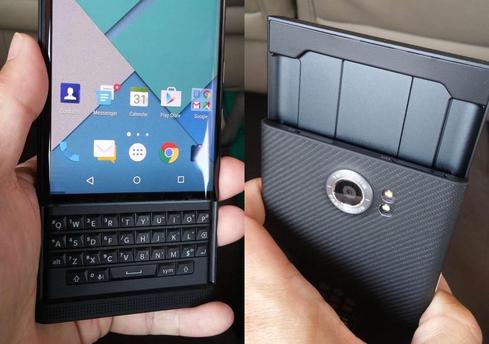Images of the long-rumored BlackBerry Venice, which features a slide-out QWERTY keyboard and uses Google's Android OS, have leaked onto the Web.


Samsung Galaxy Note 5, S6 Edge+: Side By Side
Samsung Galaxy Note 5, S6 Edge+: Side By Side (Click image for larger view and slideshow.)
The BlackBerry Venice, the beleaguered company's long-rumored smartphone that runs Google's Android operating system, may be close to entering the market after photos of the unconfirmed device showed up on a pair of Vietnamese-language sites: Tinhte and Techrum.
The leaked photos show a handset sporting a slide-out QWERTY keyboard and BlackBerry's logo on the device. There is also a roughly textured back battery cover and casing that could make the smartphone easier to hold.
The two batches of photos show a device that also looks very similar to one that had leaked in August on Twitter by Evan Blass, a tech industry blogger with a history of leaking information about upcoming phones. Earlier this year Blass posted photos of LG's G4 Android smartphone.
If all this proves true, the Venice would be the company's first smartphone running Android, although BlackBerry has reached out in the other direction on the software side of things by bringing its messaging application -- BBM -- to Apple iOS, Android, and Windows Phone devices.
BlackBerry users also have access to a host of applications through Amazon's Android-based Appstore, as well as a selection of apps designed in-house.
Though a powerhouse player in the years before the iPhone re-invented the mobile game, and before devoted "Crackberry" obsessives left the platform in droves, BlackBerry has struggled for years to stay relevant while watching its marketshare decimated by Apple and a host of low-cost Android devices.
The company currently offers six smartphone models, half of which include a physical keyboard, which makes BlackBerry unique among smartphone manufacturers.
In addition to the physical keyboard, BlackBerry's other core areas of focus were on battery performance, limited use of carrier network resources, and secure messaging and email -- attributes that were designed to appeal to business users who also jumped on the iPhone bandwagon.
BlackBerry was caught off-guard by the iPhone and was thus doomed to the basement of the smartphone market. Now, the company is trying to make a comeback.
In June, images of a handset called the BlackBerry Passport 2, or Oslo, surfaced on the technology blog N4BB, with photos showing a BlackBerry handset with a very similar design to the company's current Passport smartphone. The Passport was released in October. It features a 4.5-inch square display and the company's trademark physical QWERTY keyboard.
[Read more about smartphones and enterprise security.]
However, the corners of the device appear to be much rounder than the sharp edges of the Passport are. The Oslo -- which may just be a temporary moniker for the smartphone -- also sports a silver plastic-and-steel frame.
By the end of 2014, BlackBerry's share of the global mobile operating system market stood at only 0.4%, according to an IDC report from February. That number represented a decline of nearly 70% from that of 2013.
However, CEO John Chen said he anticipates 10 million units will be shipped in 2015, returning the company to profitability and marking a 72% increase over the 5.8 million units shipped in 2014.
About the Author(s)
You May Also Like







